Interview with Leland Cobain
Leland Cobain isn't quick to offer alternatives for his grandson's cause of death but the way the gun rested neatly on Kurt's body makes him wonder if suicide was the real reason.
By Jeff BurlingameDaily World A&E editor
It's the blue eyes that nail you. Transfixing, piercing and eerily familiar they're everywhere this week. Watching you while you're shopping. Peeking at you while you flip past them in search of a favorite TV show. Stirring pots of homemade spaghetti sauce on a stove in Montesano.
Eighty years of knowledge lie behind those eyes with nary a fact forgotten, save for the name of a just-introduced acquaintance or an insignificant piece of daily minutiae. But not family Leland Cobain remembers everything about them. The excellent artwork of his late wife, Iris, and son, Jim. The suicides of two of his brothers. The precious few visits with great-granddaughter Frances.
And nearly everything about grandson Kurt Cobain, the rock 'n' roll legend who shared the same spellbinding blue eyes. Those who travel across the world, phone cross-country or invest 37 cents in a stamp to hear that particular legend and there are many wouldn't have it any other way. "I don't mind talking about it," Leland Cobain says. "I was very proud of Kurt. I answer their letters. When I get a letter, if it's interesting, I'll sit down and answer it right then. I don't put it off. I never get tired of it."
Leland Cobain's use of the past tense in reference to his grandson began on April 8, 1994. That's when his wife answered a phone call from Kurt's distraught mother, Wendy O'Connor. It wasn't the news Leland Cobain, his wife, or thousands of others for that matter, wanted to hear. "It was pretty sad," Leland Cobain says. "I didn't believe it. I couldn't believe it was suicide. Still don't."
Leland Cobain isn't quick to offer alternatives for his grandson's cause of death but the way the gun rested neatly on Kurt's body makes him wonder if suicide was the real reason. Unlike many who've had a loved one die by their own hand, he isn't in denial, just curious for answers and fueled by books and reports he's read about murder plots and suspicious deaths of people involved in the investigation and a thorough knowledge of his grandson's character.
"People always say he was on the dope, but I'll tell you what, when he came to visit us he was never on the dope," Leland Cobain says. "He was as clear-eyed as you and I."
There are many in the world whose eyes weren't clear, including Leland and Iris Cobain's, 10 years ago this week when Kurt Cobain was found dead above the garage of his Seattle home. His death certificate lists the cause as suicide by a self-inflicted shotgun wound, the official date: April 5, 1994, three days before his body was discovered by an electrician.
In the less than three years Kurt Cobain and his band, Nirvana, were on top of the rock 'n' roll world from shortly after the release of 1991's trend-changing, 14-million selling "Nevermind" to his premature death at 27 he changed the direction of music for all time.
A high school dropout from Aberdeen had knocked Garth Brooks and Michael Jackson from the Billboard charts. In "Smells Like Teen Spirit," he'd produced the "Stairway to Heaven" of an angst-riddled generation a song bound to become a classic rock radio staple for decades and generations to follow. He put a stick pin in the Aberdeen dot on the musical map, yet it remains a place many in the city seem reluctant to be.
"I'm not sure why there isn't anything anywhere," Leland Cobain says. "Like a sign, I think that'd be a good deal. A lot of these tourists, they'd be going by with their kids, heading to Ocean Shores or Westport and they'd see that sign and say, C'mon, Dad, I want to stop and see that.' "
Underneath the North Aberdeen Bridge where Kurt Cobain's tarp once supposedly sprung a leak, a deserted pink rose lies decaying into the muddy banks of the Wishkah River.
Likely dropped by a fan as tribute to a fallen hero, the flower is surrounded by empty Budweiser cans, plastic 7-Eleven grocery bags and a
pristine "Nevermind" CD, held upright by a drying, well-placed dab of malodorous mud.
A rusty water pipe guards entrance to the makeshift shrine and is adorned with a scribbled and faded "COME AS YOU ARE" in weather-weakened white chalk. Hundreds of similar scratchings are under the bridge, many faded, many more fresh. All intended to honor a man 10 years dead that none of the authors knew but all traveled long distances to try to:
Kurt, I live in NY. I traveled all the way to see this. I want you to know
that for years I've listened to you. I believe you are here for all of us.
No one will ever forget your impact on Aberdeen. If only you could have known all this, maybe you would have stayed then I could meet you when I come from France.
Kurt Cobain's death inspired generations of lyrics, troubled teens' suicides and wannabe artists minds filled with guilt, failed prosperity and hopeful desire. Yet the effect on Kurt Cobain's hometown was minimal. Ten years later, it still is. The Beatles have Liverpool. Elvis has Memphis. Kurt Cobain has Aberdeen, where there's little to remember him but a bridge he may or may not have slept under.
Page 1 | Page 2
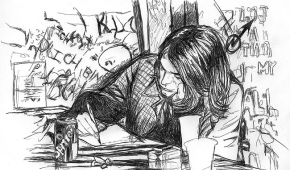

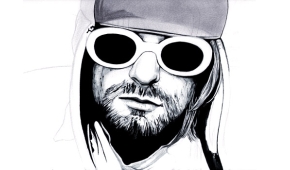


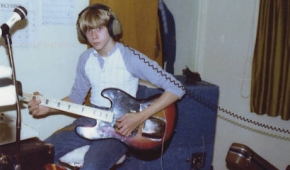


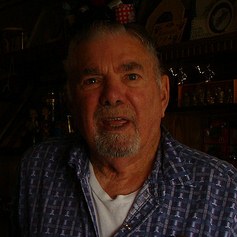 Leland Cobain is the only member of the Cobain family that is willing to
talk to Nirvana fans about his grandson. He lives in a trailer in Montesano,
a couple hours outside of Aberdeen, and spends his days answering mail about
Kurt Cobain, taking phone calls, and visiting with superfans making a
pilgrimage to Cobain’s old haunts.
Leland Cobain is the only member of the Cobain family that is willing to
talk to Nirvana fans about his grandson. He lives in a trailer in Montesano,
a couple hours outside of Aberdeen, and spends his days answering mail about
Kurt Cobain, taking phone calls, and visiting with superfans making a
pilgrimage to Cobain’s old haunts.  Except
for Don, Leland doesn't have much of a relationship with anyone else connected
to Kurt. He hasn't seen Frances since she was a toddler, and he and Wendy,
Kurt's mom, were never especially friendly. He's also on Courtney's shit list
for publicly raising questions about Kurt's death. He was quoted in an April
2004 issue of People saying he thought Kurt was murdered.
Except
for Don, Leland doesn't have much of a relationship with anyone else connected
to Kurt. He hasn't seen Frances since she was a toddler, and he and Wendy,
Kurt's mom, were never especially friendly. He's also on Courtney's shit list
for publicly raising questions about Kurt's death. He was quoted in an April
2004 issue of People saying he thought Kurt was murdered. 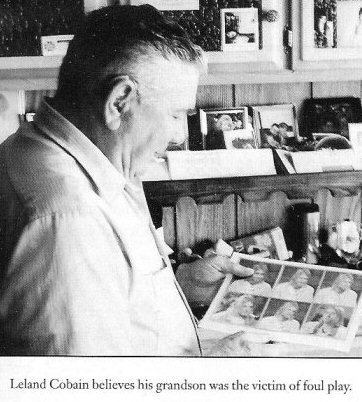 "I
have no idea who done it, but I think the cops in Seattle really goofed up," he
says. "I can't understand how he could have that much dope in him and still lift
a shotgun. And I can't understand how come his jaws weren't all broke up and
everything from the concussion when it went off and why (the gun) was still on
his chest — it should have jumped clear off his chest."
"I
have no idea who done it, but I think the cops in Seattle really goofed up," he
says. "I can't understand how he could have that much dope in him and still lift
a shotgun. And I can't understand how come his jaws weren't all broke up and
everything from the concussion when it went off and why (the gun) was still on
his chest — it should have jumped clear off his chest." 